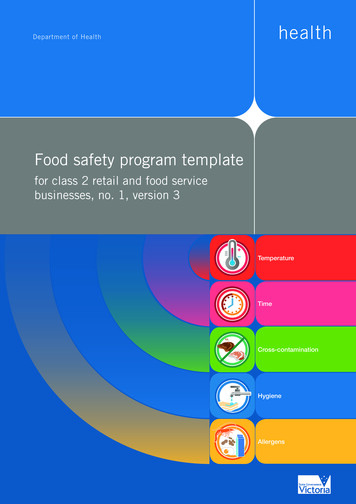
Transcription
HIGHLIGHTS OF PRESCRIBING INFORMATIONThese highlights do not include all the information needed to use BREOELLIPTA safely and effectively. See full prescribing information forBREO ELLIPTA. BREO ELLIPTA (fluticasone furoate and vilanterol inhalation powder)FOR ORAL INHALATION USEInitial U.S. Approval: 2013 WARNING: ASTHMA-RELATED DEATHSee full prescribing information for complete boxed warning.Long-acting beta2-adrenergic agonists (LABA), such as vilanterol,one of the active ingredients in BREO ELLIPTA, increase the risk ofasthma-related death. A placebo-controlled trial with another LABA(salmeterol) showed an increase in asthma-related deaths in subjectsreceiving salmeterol. This finding with salmeterol is considered aclass effect of all LABA, including vilanterol. (5.1)The safety and efficacy of BREO ELLIPTA in patients with asthmahave not been established. BREO ELLIPTA is not indicated for thetreatment of asthma. (5.1) Increased risk of pneumonia in patients with COPD taking BREOELLIPTA. Monitor patients for signs and symptoms of pneumonia. (5.5)Potential worsening of infections (e.g., existing tuberculosis; fungal,bacterial, viral, or parasitic infection; ocular herpes simplex). Use withcaution in patients with these infections. More serious or even fatal courseof chickenpox or measles can occur in susceptible patients. (5.6)Risk of impaired adrenal function when transferring from systemiccorticosteroids. Taper patients slowly from systemic corticosteroids iftransferring to BREO ELLIPTA. (5.7)Hypercorticism and adrenal suppression may occur with very highdosages or at the regular dosage in susceptible individuals. If suchchanges occur, discontinue BREO ELLIPTA slowly. (5.8)If paradoxical bronchospasm occurs, discontinue BREO ELLIPTA andinstitute alternative therapy. (5.10)Use with caution in patients with cardiovascular disorders because ofbeta-adrenergic stimulation. (5.12)Assess for decrease in bone mineral density initially and periodicallythereafter. (5.13)Close monitoring for glaucoma and cataracts is warranted. (5.14)Use with caution in patients with convulsive disorders, thyrotoxicosis,diabetes mellitus, and ketoacidosis. (5.15)Be alert to hypokalemia and hyperglycemia. (5.16)----------------------------INDICATIONS AND USAGE --------------------------- BREO ELLIPTA is a combination of fluticasone furoate, an inhaledcorticosteroid (ICS), and vilanterol, a long-acting beta2-adrenergic agonist(LABA), indicated for long-term, once-daily, maintenance treatment ofairflow obstruction and for reducing exacerbations in patients with chronicobstructive pulmonary disease (COPD). (1) Important limitations: Not indicated for relief of acute bronchospasm or fortreatment of asthma. (1, 5.2)To report SUSPECTED ADVERSE REACTIONS, contactGlaxoSmithKline at 1-888-825-5249 or FDA at 1-800-FDA-1088 --- ADVERSE REACTIONS ----------------------------- Most common adverse reactions (incidence 3%) are nasopharyngitis, upperrespiratory tract infection, headache, and oral candidiasis. (6.1)----------------------- DOSAGE AND ADMINISTRATION ---------------------- For oral inhalation only. (2) Maintenance treatment of COPD: 1 inhalation of BREO ELLIPTA100 mcg/25 mcg once daily. (2)-------------------------------DRUG INTERACTIONS ------------------------------ Strong cytochrome P450 3A4 inhibitors (e.g., ketoconazole): Use withcaution. May cause systemic corticosteroid and cardiovascular effects.(7.1) Monoamine oxidase inhibitors and tricyclic antidepressants: Use withextreme caution. May potentiate effect of vilanterol on vascular system.(7.2) Beta-blockers: Use with caution. May block bronchodilatory effects ofbeta-agonists and produce severe bronchospasm. (7.3) Diuretics: Use with caution. Electrocardiographic changes and/orhypokalemia associated with non–potassium-sparing diuretics mayworsen with concomitant beta-agonists. (7.4)--------------------- DOSAGE FORMS AND STRENGTHS -------------------- Inhalation Powder. Inhaler containing 2 double-foil blister strips of powderformulation for oral inhalation. One strip contains fluticasone furoate 100 mcgper blister and the other contains vilanterol 25 mcg per blister. S ------------------------------ Severe hypersensitivity to milk proteins or any ingredients. (4)----------------------- WARNINGS AND PRECAUTIONS----------------------- LABA increase the risk of asthma-related death. (5.1) Do not initiate in acutely deteriorating COPD or to treat acute symptoms.(5.2) Do not use in combination with an additional medicine containing LABAbecause of risk of overdose. (5.3) Candida albicans infection of the mouth and pharynx may occur. Monitorpatients periodically. Advise the patient to rinse his/her mouth withoutswallowing after inhalation to help reduce the risk. (5.4)----------------------- USE IN SPECIFIC POPULATIONS ---------------------- Hepatic impairment: Fluticasone furoate exposure may increase in patientswith moderate or severe impairment. Monitor for systemic corticosteroideffects. (8.6, 12.3)See 17 for PATIENT COUNSELING INFORMATION and MedicationGuide.Revised: 9/2015FULL PRESCRIBING INFORMATION: CONTENTS*FULL PRESCRIBING INFORMATIONWARNING: ASTHMA-RELATED DEATH1 INDICATIONS AND USAGE2 DOSAGE AND ADMINISTRATION3 DOSAGE FORMS AND STRENGTHS4 CONTRAINDICATIONS5 WARNINGS AND PRECAUTIONS5.1 Asthma-Related Death5.2 Deterioration of Disease and Acute Episodes5.3 Excessive Use of BREO ELLIPTA and Use With OtherLong-Acting Beta2-Agonists5.4 Local Effects of Inhaled Corticosteroids5.5 Pneumonia5.6 Immunosuppression5.7 Transferring Patients From Systemic CorticosteroidTherapy5.8 Hypercorticism and Adrenal Suppression5.9 Drug Interactions With Strong Cytochrome P450 3A4Inhibitors6781Reference ID: 38198435.10 Paradoxical Bronchospasm5.11 Hypersensitivity Reactions, Including Anaphylaxis5.12 Cardiovascular Effects5.13 Reduction in Bone Mineral Density5.14 Glaucoma and Cataracts5.15 Coexisting Conditions5.16 Hypokalemia and HyperglycemiaADVERSE REACTIONS6.1 Clinical Trials Experience6.2 Postmarketing ExperienceDRUG INTERACTIONS7.1 Inhibitors of Cytochrome P450 3A47.2 Monoamine Oxidase Inhibitors and TricyclicAntidepressants7.3 Beta-Adrenergic Receptor Blocking Agents7.4 Non–Potassium-Sparing DiureticsUSE IN SPECIFIC POPULATIONS8.1 Pregnancy8.2 Labor and Delivery8.3 Nursing Mothers8.4 Pediatric Use
1011121314 CLINICAL STUDIES14.1 Dose-Ranging Trials14.2 Confirmatory Trials16 HOW SUPPLIED/STORAGE AND HANDLING17 PATIENT COUNSELING INFORMATION17.1 Asthma-Related Death17.2 Not for Acute Symptoms17.3 Do Not Use Additional Long-Acting Beta2-Agonists17.4 Risks Associated With Corticosteroid Therapy17.5 Risks Associated With Beta-Agonist Therapy17.6 Hypersensitivity Reactions, Including Anaphylaxis*Sections or subsections omitted from the full prescribing information are notlisted.8.5 Geriatric Use8.6 Hepatic Impairment8.7 Renal ImpairmentOVERDOSAGE10.1 Fluticasone Furoate10.2 VilanterolDESCRIPTIONCLINICAL PHARMACOLOGY12.1 Mechanism of Action12.2 Pharmacodynamics12.3 PharmacokineticsNONCLINICAL TOXICOLOGY13.1 Carcinogenesis, Mutagenesis, Impairment of FertilityFULL PRESCRIBING INFORMATIONWARNING: ASTHMA-RELATED DEATHLong-acting beta2-adrenergic agonists (LABA) increase the risk of asthma-relateddeath. Data from a large placebo-controlled US trial that compared the safety of anotherLABA (salmeterol) with placebo added to usual asthma therapy showed an increase inasthma-related deaths in subjects receiving salmeterol. This finding with salmeterol isconsidered a class effect of LABA, including vilanterol, an active ingredient in BREO ELLIPTA [see Warnings and Precautions (5.1)].The safety and efficacy of BREO ELLIPTA in patients with asthma have not beenestablished. BREO ELLIPTA is not indicated for the treatment of asthma.1INDICATIONS AND USAGEBREO ELLIPTA is a combination inhaled corticosteroid/long-acting beta2-adrenergicagonist (ICS/LABA) indicated for the long-term, once-daily, maintenance treatment of airflowobstruction in patients with chronic obstructive pulmonary disease (COPD), including chronicbronchitis and/or emphysema. BREO ELLIPTA is also indicated to reduce exacerbations ofCOPD in patients with a history of exacerbations.Important Limitations of Use: BREO ELLIPTA is NOT indicated for the relief of acutebronchospasm or for the treatment of asthma.2DOSAGE AND ADMINISTRATIONBREO ELLIPTA 100 mcg/25 mcg should be administered as 1 inhalation once daily bythe orally inhaled route only. After inhalation, the patient should rinse his/her mouth with waterwithout swallowing to help reduce the risk of oropharyngeal candidiasis.BREO ELLIPTA should be taken at the same time every day. Do not use BREOELLIPTA more than 1 time every 24 hours.No dosage adjustment is required for geriatric patients, patients with hepatic impairment,or renally impaired patients [see Clinical Pharmacology (12.3)].3DOSAGE FORMS AND STRENGTHSInhalation Powder. Disposable light grey and pale blue plastic inhaler containing 2double-foil blister strips, each with 30 blisters containing powder intended for oral inhalationonly. One strip contains fluticasone furoate (100 mcg per blister), and the other strip contains2Reference ID: 3819843
vilanterol (25 mcg per blister). An institutional pack containing 14 blisters per strip is alsoavailable.4CONTRAINDICATIONSThe use of BREO ELLIPTA is contraindicated in patients with severe hypersensitivity tomilk proteins or who have demonstrated hypersensitivity to either fluticasone furoate, vilanterol,or any of the excipients [see Warnings and Precautions (5.11), Description (11)].5WARNINGS AND PRECAUTIONS5.1Asthma-Related Death Data from a large placebo-controlled trial in subjects with asthma showed that LABA mayincrease the risk of asthma-related death. Data are not available to determine whether therate of death in patients with COPD is increased by LABA. A 28-week, placebo-controlled, US trial comparing the safety of another LABA (salmeterol)with placebo, each added to usual asthma therapy, showed an increase in asthma-relateddeaths in subjects receiving salmeterol (13/13,176 in subjects treated with salmeterol vs3/13,179 in subjects treated with placebo; relative risk: 4.37 [95% CI: 1.25, 15.34]). Theincreased risk of asthma-related death is considered a class effect of LABA, includingvilanterol, one of the active ingredients in BREO ELLIPTA. No study adequate to determine whether the rate of asthma-related death is increased insubjects treated with BREO ELLIPTA has been conducted. The safety and efficacy of BREOELLIPTA in patients with asthma have not been established. BREO ELLIPTA is notindicated for the treatment of asthma.5.2Deterioration of Disease and Acute EpisodesBREO ELLIPTA should not be initiated in patients during rapidly deteriorating orpotentially life-threatening episodes of COPD. BREO ELLIPTA has not been studied in patientswith acutely deteriorating COPD. The initiation of BREO ELLIPTA in this setting is notappropriate.BREO ELLIPTA should not be used for the relief of acute symptoms, i.e., as rescuetherapy for the treatment of acute episodes of bronchospasm. BREO ELLIPTA has not beenstudied in the relief of acute symptoms and extra doses should not be used for that purpose.Acute symptoms should be treated with an inhaled, short-acting beta2-agonist.When beginning treatment with BREO ELLIPTA, patients who have been taking oral orinhaled, short-acting beta2-agonists on a regular basis (e.g., 4 times a day) should be instructed todiscontinue the regular use of these drugs and to use them only for symptomatic relief of acuterespiratory symptoms. When prescribing BREO ELLIPTA, the healthcare provider should alsoprescribe an inhaled, short-acting beta2-agonist and instruct the patient on how it should be used.Increasing inhaled, short-acting beta2-agonist use is a signal of deteriorating disease for whichprompt medical attention is indicated.COPD may deteriorate acutely over a period of hours or chronically over several days orlonger. If BREO ELLIPTA no longer controls symptoms of bronchoconstriction; the patient’s3Reference ID: 3819843
inhaled, short-acting, beta2-agonist becomes less effective; or the patient needs more short-actingbeta2-agonist than usual, these may be markers of deterioration of disease. In this setting are-evaluation of the patient and the COPD treatment regimen should be undertaken at once.Increasing the daily dose of BREO ELLIPTA beyond the recommended dose is not appropriatein this situation.5.3Excessive Use of BREO ELLIPTA and Use With Other Long-ActingBeta2-AgonistsBREO ELLIPTA should not be used more often than recommended, at higher doses thanrecommended, or in conjunction with other medicines containing LABA, as an overdose mayresult. Clinically significant cardiovascular effects and fatalities have been reported inassociation with excessive use of inhaled sympathomimetic drugs. Patients using BREOELLIPTA should not use another medicine containing a LABA (e.g., salmeterol, formoterolfumarate, arformoterol tartrate, indacaterol) for any reason.5.4Local Effects of Inhaled CorticosteroidsIn clinical trials, the development of localized infections of the mouth and pharynx withCandida albicans has occurred in subjects treated with BREO ELLIPTA. When such aninfection develops, it should be treated with appropriate local or systemic (i.e., oral) antifungaltherapy while treatment with BREO ELLIPTA continues, but at times therapy with BREOELLIPTA may need to be interrupted. Advise the patient to rinse his/her mouth withoutswallowing following inhalation to help reduce the risk of oropharyngeal candidiasis.5.5PneumoniaAn increase in the incidence of pneumonia has been observed in subjects with COPDreceiving the fluticasone furoate/vilanterol combination, including BREO ELLIPTA100 mcg/25 mcg, in clinical trials. There was also an increased incidence of pneumoniasresulting in hospitalization. In some incidences these pneumonia events were fatal. Physiciansshould remain vigilant for the possible development of pneumonia in patients with COPD as theclinical features of such infections overlap with the symptoms of COPD exacerbations.In replicate 12-month trials in 3,255 subjects with COPD who had experienced a COPDexacerbation in the previous year, there was a higher incidence of pneumonia reported insubjects receiving the fluticasone furoate/vilanterol combination (50 mcg/25 mcg: 6% [48 of 820subjects]; 100 mcg/25 mcg: 6% [51 of 806 subjects]; or 200 mcg/25 mcg: 7% [55 of 811subjects]) than in subjects receiving vilanterol 25 mcg (3% [27 of 818 subjects]). There was nofatal pneumonia in subjects receiving vilanterol or fluticasone furoate/vilanterol 50 mcg/25 mcg.There was fatal pneumonia in 1 subject receiving fluticasone furoate/vilanterol 100 mcg/25 mcgand in 7 subjects receiving fluticasone furoate/vilanterol 200 mcg/25 mcg (less than 1% for eachtreatment group).5.6ImmunosuppressionPersons who are using drugs that suppress the immune system are more susceptible toinfections than healthy individuals. Chickenpox and measles, for example, can have a moreserious or even fatal course in susceptible children or adults using corticosteroids. In such4Reference ID: 3819843
children or adults who have not had these diseases or been properly immunized, particular careshould be taken to avoid exposure. How the dose, route, and duration of corticosteroidadministration affect the risk of developing a disseminated infection is not known. Thecontribution of the underlying disease and/or prior corticosteroid treatment to the risk is also notknown. If a patient is exposed to chickenpox, prophylaxis with varicella zoster immune globulin(VZIG) may be indicated. If a patient is exposed to measles, prophylaxis with pooledintramuscular immunoglobulin (IG) may be indicated. (See the respective package inserts forcomplete VZIG and IG prescribing information.) If chickenpox develops, treatment withantiviral agents may be considered.Inhaled corticosteroids should be used with caution, if at all, in patients with active orquiescent tuberculosis infections of the respiratory tract; systemic fungal, bacterial, viral, orparasitic infections; or ocular herpes simplex.5.7Transferring Patients From Systemic Corticosteroid TherapyParticular care is needed for patients who have been transferred from systemically activecorticosteroids to inhaled corticosteroids because deaths due to adrenal insufficiency haveoccurred in patients with asthma during and after transfer from systemic corticosteroids to lesssystemically available inhaled corticosteroids. After withdrawal from systemic corticosteroids, anumber of months are required for recovery of hypothalamic-pituitary-adrenal (HPA) function.Patients who have been previously maintained on 20 mg or more of prednisone (or itsequivalent) may be most susceptible, particularly when their systemic corticosteroids have beenalmost completely withdrawn. During this period of HPA suppression, patients may exhibit signsand symptoms of adrenal insufficiency when exposed to trauma, surgery, or infection(particularly gastroenteritis) or other conditions associated with severe electrolyte loss. AlthoughBREO ELLIPTA may control COPD symptoms during these episodes, in recommended doses itsupplies less than normal physiological amount of glucocorticoid systemically and does NOTprovide the mineralocorticoid activity that is necessary for coping with these emergencies.During periods of stress or a severe COPD exacerbation, patients who have beenwithdrawn from systemic corticosteroids should be instructed to resume oral corticosteroids (inlarge doses) immediately and to contact their physicians for further instruction. These patientsshould also be instructed to carry a warning card indicating that they may need supplementarysystemic corticosteroids during periods of stress or severe COPD exacerbation.Patients requiring oral corticosteroids should be weaned slowly from systemiccorticosteroid use after transferring to BREO ELLIPTA. Prednisone reduction can beaccomplished by reducing the daily prednisone dose by 2.5 mg on a weekly basis during therapywith BREO ELLIPTA. Lung function (mean forced expiratory volume in 1 second [FEV1]),beta-agonist use, and COPD symptoms should be carefully monitored during withdrawal of oralcorticosteroids. In addition, patients should be observed for signs and symptoms of adrenalinsufficiency, such as fatigue, lassitude, weakness, nausea and vomiting, and hypotension.5Reference ID: 3819843
Transfer of patients from systemic corticosteroid therapy to BREO ELLIPTA mayunmask allergic conditions previously suppressed by the systemic corticosteroid therapy (e.g.,rhinitis, conjunctivitis, eczema, arthritis, eosinophilic conditions).During withdrawal from oral corticosteroids, some patients may experience symptoms ofsystemically active corticosteroid withdrawal (e.g., joint and/or muscular pain, lassitude,depression) despite maintenance or even improvement of respiratory function.5.8Hypercorticism and Adrenal SuppressionInhaled fluticasone furoate is absorbed into the circulation and can be systemically active.Effects of fluticasone furoate on the HPA axis are not observed with the therapeutic dose ofBREO ELLIPTA. However, exceeding the recommended dosage or coadministration with astrong cytochrome P450 3A4 (CYP3A4) inhibitor may result in HPA dysfunction [see Warningsand Precautions (5.9), Drug Interactions (7.1)].Because of the possibility of significant systemic absorption of inhaled corticosteroids insensitive patients, patients treated with BREO ELLIPTA should be observed carefully for anyevidence of systemic corticosteroid effects. Particular care should be taken in observing patientspostoperatively or during periods of stress for evidence of inadequate adrenal response.It is possible that systemic corticosteroid effects such as hypercorticism and adrenalsuppression (including adrenal crisis) may appear in a small number of patients who are sensitiveto these effects. If such effects occur, BREO ELLIPTA should be reduced slowly, consistentwith accepted procedures for reducing systemic corticosteroids, and other treatments formanagement of COPD symptoms should be considered.5.9Drug Interactions With Strong Cytochrome P450 3A4 InhibitorsCaution should be exercised when considering the coadministration of BREO ELLIPTAwith long-term ketoconazole and other known strong CYP3A4 inhibitors (e.g., ritonavir,clarithromycin, conivaptan, indinavir, itraconazole, lopinavir, nefazodone, nelfinavir, saquinavir,telithromycin, troleandomycin, voriconazole) because increased systemic corticosteroid andincreased cardiovascular adverse effects may occur [see Drug Interactions (7.1), ClinicalPharmacology (12.3)].5.10 Paradoxical BronchospasmAs with other inhaled medicines, BREO ELLIPTA can produce paradoxicalbronchospasm, which may be life threatening. If paradoxical bronchospasm occurs followingdosing with BREO ELLIPTA, it should be treated immediately with an inhaled, short-actingbronchodilator; BREO ELLIPTA should be discontinued immediately; and alternative therapyshould be instituted.5.11 Hypersensitivity Reactions, Including AnaphylaxisHypersensitivity reactions such as anaphylaxis, angioedema, rash, and urticaria mayoccur after administration of BREO ELLIPTA. Discontinue BREO ELLIPTA if such reactionsoccur. There have been reports of anaphylactic reactions in patients with severe milk proteinallergy after inhalation of other powder medications containing lactose; therefore, patients withsevere milk protein allergy should not use BREO ELLIPTA [see Contraindications (4)].6Reference ID: 3819843
5.12Cardiovascular EffectsVilanterol, like other beta2-agonists, can produce a clinically significant cardiovasculareffect in some patients as measured by increases in pulse rate, systolic or diastolic bloodpressure, and also cardiac arrhythmias, such as supraventricular tachycardia and extrasystoles. Ifsuch effects occur, BREO ELLIPTA may need to be discontinued. In addition, beta-agonistshave been reported to produce electrocardiographic changes, such as flattening of the T wave,prolongation of the QTc interval, and ST segment depression, although the clinical significanceof these findings is unknown. In healthy subjects, large doses of inhaled fluticasonefuroate/vilanterol (4 times the recommended dose of vilanterol, representing a 12-fold highersystemic exposure than seen in patients with COPD) have been associated with clinicallysignificant prolongation of the QTc interval, which has the potential for producing ventriculararrhythmias. Therefore, BREO ELLIPTA, like other sympathomimetic amines, should be usedwith caution in patients with cardiovascular disorders, especially coronary insufficiency, cardiacarrhythmias, and hypertension.5.13 Reduction in Bone Mineral DensityDecreases in bone mineral density (BMD) have been observed with long-termadministration of products containing inhaled corticosteroids. The clinical significance of smallchanges in BMD with regard to long-term consequences such as fracture is unknown. Patientswith major risk factors for decreased bone mineral content, such as prolonged immobilization,family history of osteoporosis, postmenopausal status, tobacco use, advanced age, poor nutrition,or chronic use of drugs that can reduce bone mass (e.g., anticonvulsants, oral corticosteroids)should be monitored and treated with established standards of care. Since patients with COPDoften have multiple risk factors for reduced BMD, assessment of BMD is recommended prior toinitiating BREO ELLIPTA and periodically thereafter. If significant reductions in BMD are seenand BREO ELLIPTA is still considered medically important for that patient’s COPD therapy,use of medicine to treat or prevent osteoporosis should be strongly considered.In replicate 12-month trials in 3,255 subjects with COPD, bone fractures were reportedby 2% of subjects receiving the fluticasone furoate/vilanterol combination (50 mcg/25 mcg: 2%[14 of 820 subjects]; 100 mcg/25 mcg: 2% [19 of 806 subjects]; or 200 mcg/25 mcg: 2% [14 of811 subjects]) than in subjects receiving vilanterol 25 mcg alone (less than 1% [8 of 818subjects]).5.14 Glaucoma and CataractsGlaucoma, increased intraocular pressure, and cataracts have been reported in patientswith COPD following the long-term administration of inhaled corticosteroids. Therefore, closemonitoring is warranted in patients with a change in vision or with a history of increasedintraocular pressure, glaucoma, and/or cataracts.In replicate 12-month trials in 3,255 subjects with COPD, similar incidences of oculareffects (including glaucoma and cataracts) were reported in subjects receiving the fluticasonefuroate/vilanterol combination (50 mcg/25 mcg: less than 1% [7 of 820 subjects];7Reference ID: 3819843
100 mcg/25 mcg: 1% [12 of 806 subjects]; 200 mcg/25 mcg: less than 1% [7 of 811 subjects]) asthose receiving vilanterol 25 mcg alone (1% [9 of 818 subjects]).5.15 Coexisting ConditionsBREO ELLIPTA, like all medicines containing sympathomimetic amines, should be usedwith caution in patients with convulsive disorders or thyrotoxicosis and in those who areunusually responsive to sympathomimetic amines. Doses of the related beta2-adrenoceptoragonist albuterol, when administered intravenously, have been reported to aggravate preexistingdiabetes mellitus and ketoacidosis.5.16 Hypokalemia and HyperglycemiaBeta-adrenergic agonist medicines may produce significant hypokalemia in somepatients, possibly through intracellular shunting, which has the potential to produce adversecardiovascular effects. The decrease in serum potassium is usually transient, not requiringsupplementation. Beta-agonist medications may produce transient hyperglycemia in somepatients. In 4 clinical trials of 6- and 12-month duration evaluating BREO ELLIPTA in subjectswith COPD, there was no evidence of a treatment effect on serum glucose or potassium.6ADVERSE REACTIONSLABA, such as vilanterol, one of the active ingredients in BREO ELLIPTA, increase therisk of asthma-related death. BREO ELLIPTA is not indicated for the treatment of asthma. [SeeBoxed Warnings and Warnings and Precautions (5.1).]Systemic and local corticosteroid use may result in the following: Increased risk of pneumonia in COPD [see Warnings and Precautions (5.5)] Increased risk for decrease in bone mineral density [see Warnings and Precautions (5.13)]6.1Clinical Trials ExperienceBecause clinical trials are conducted under widely varying conditions, adverse reactionrates observed in the clinical trials of a drug cannot be directly compared with rates in theclinical trials of another drug and may not reflect the rates observed in practice.The clinical program for BREO ELLIPTA included 7,700 subjects with COPD in two6-month lung function trials, two 12-month exacerbation trials, and 6 other trials of shorterduration. A total of 2,034 subjects have received at least 1 dose of BREO ELLIPTA100 mcg/25 mcg, and 1,087 subjects have received higher doses of fluticasone furoate/vilanterol.The safety data described below are based on the confirmatory 6-month and 12-month trials.Adverse reactions observed in the other trials were similar to those observed in the confirmatorytrials.6-Month Trials: The incidence of adverse reactions associated with BREO ELLIPTA inTable 1 is based on 2 placebo-controlled, 6-month clinical trials (Trials 1 and 2; n 1,224 andn 1,030, respectively). Of the 2,254 subjects, 70% were male and 84% were Caucasian. Theyhad a mean age of 62 years and an average smoking history of 44 pack years, with 54%identified as current smokers. At screening, the mean postbronchodilator percent predicted FEV1was 48% (range: 14% to 87%), the mean postbronchodilator FEV1/forced vital capacity (FVC)8Reference ID: 3819843
ratio was 47% (range: 17% to 88%), and the mean percent reversibility was 14% (range: -41% to152%).Subjects received 1 inhalation once daily of the following: BREO ELLIPTA100 mcg/25 mcg, fluticasone furoate/vilanterol 50 mcg/25 mcg, fluticasone furoate/vilanterol200 mcg/25 mcg, fluticasone furoate 100 mcg, fluticasone furoate 200 mcg, vilanterol 25 mcg, orplacebo.Table 1. Adverse Reactions With 3% Incidence and More Common Than Placebo WithBREO ELLIPTA in Subjects With Chronic Obstructive Pulmonary DiseaseBREOELLIPTA100 mcg/25 mcg(n 410)%Vilanterol25 mcg(n 408)%FluticasoneFuroate100 mcg(n 410)%Placebo(n 412)%Adverse EventInfections andinfestationsNasopharyngitis91088Upper respiratory7543tract infectionOropharyngeal5232acandidiasisNervous systemdisordersHeadache7975aIncludes terms oral candidiasis, oropharyngeal candidiasis, candidiasis, and oropharyngitisfungal.12-Month Trials: Long-term safety data is based on two 12-month trials (Trials 3 and 4;n 1,633 and n 1,622, respectively). Trials 3 and 4 included 3,255 subjects, of which 57%were male and 85% were Caucasian. They had a mean age of 64 years and an average smokinghistory of 46 pack years, with 44% identified as current smokers. At screening, the meanpostbronchodilator percent predicted FEV1 was 45% (range: 12% to 91%), and the meanpostbronchodilator FEV1/FVC ratio was 46% (range: 17% to 81%), indicating that the subjectpopulation had moderate to very severely impaired airflow obstruction. Subjects received 1inhalation once daily of the following: BREO ELLIPTA 100 mcg/25 mcg, fluticasonefuroate/vilanterol 50 mcg/25 mcg, fluticasone furoate/vilanterol 200 mcg/25 mcg, or vilanterol25 mcg. In addition to the events shown in Table 1, adverse reactions occurring in greater than orequal to 3% of the subjects treated with BREO ELLIPTA (N 806) for 12 months includedCOPD, back pain, pneumonia [see Warnings and Precautions (5.5)], bronchitis, sinusitis, cough,9Reference ID: 3819843 page
BREO ELLIPTA has not been studied in patients with acutely deteriorating COPD. The initiation of BREO ELLIPTA in this setting is not appropriate. BREO ELLIPTA should not be used for the relief of acute symptoms, i.e., as rescue therapy for the treatment of acute episodes of bronchospasm. BREO ELLIPTA has not been










